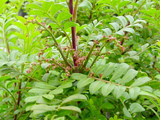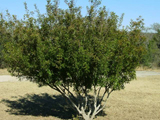Native Plants

Q. Who is Mr. Smarty Plants?
A: There are those who suspect Wildflower Center volunteers are the culpable and capable culprits. Yet, others think staff members play some, albeit small, role. You can torture us with your plant questions, but we will never reveal the Green Guru's secret identity.
Did you know you can access the Native Plant Information Network with your web-enabled smartphone?
Ask Mr. Smarty Plants is a free service provided by the staff and volunteers at the Lady Bird Johnson Wildflower Center.

rate this answer
Sunday - August 19, 2012
From: Burnet-Kempner, TX
Region: Southwest
Topic: Seed and Plant Sources, Planting, Trees
Title: Source for trees from Burnet TX
Answered by: Barbara Medford
QUESTION:
I am desperately searching the central Texas area for Pistacia Mexicana male and female trees to buy. I would like about four, maybe more. I live in the Killeen-Lampasas area and have been to several native plant nurseries already. It says on the internet they make a lot of oxygen year around and don't mind caliche soil. I also need several Mexican plum trees. Babies are OK. Thanks, Katy F.ANSWER:
Let me begin by saying puh-leeeze don't plant any woody plants right now. In fact, we are hoping that the reason you are not finding any is that the nurseries know this is a dangerous time to be moving or planting them. Transplant shock probably kills more trees than any bug or disease, and you are asking for it if you plant any time other than November to January in Central Texas.
This USDA Plant Profile Map shows Pistacia mexicana (Mexican pistachio) grows natively only to Val Verde County, in Big Bend Country of West Texas. If you follow the plant link on our webpage on this plant, you will learn that it blooms white March to August, and is endemic to Texas.
From our webpage on this plant: "Native Habitat: Limestone cliffs; ravine edge.
Growing Conditions
Light Requirement: Sun
Soil Description: Well-drained, alkaline soil.
Conditions Comments: This uncommon, handsome evergreen is drought-resistant and grows well in full sunlight and merits planting as an ornamental in warm, dry climates. In spring the new dark red foliage is showy. Clusters of small, white flowers are followed by clusters of red, nut-like drupes on females. These become almost black on drying."
All vascular plants have a process called photosynthesis, by which the energy of sunlight is used to manufacture food for the plants. From a previous Mr. Smarty Plants answer: "When sunlight strikes a leaf, a process called photosynthesis is put into play, the plant converts the energy from the sun, combines it with water and nutrients in the plant, and metabolizes it into food to support the plant, form new structures within the plant, and store food in the roots. Along the way, it releases oxygen, which is a good thing for the human race. The plant uses carbon dioxide, not good for breathing in the process, and releases much needed oxygen as a waste product!" How cool is that? From sunlight and photosynthesis the whole food chain of Nature is begun. This happens in native plants, alien plants and invasive plants. It's hard to call a plant useless. It may be irritating, poisonous, ugly, intrusive, but it is still feeding all the lifeforms on Earth and providing oxygen."
We do not know of any reason to believe the Pistacia mexicana (Mexican pistachio) would produce any more or any less oxygen than any other plant. So, if you were desperate to find this tree to add more oxygen to your atmosphere, you can stop worrying-any other tree the same size would do just as well.
Moving on to Prunus mexicana (Mexican plum); this USDA Plant Profile Map does not show it growing in Burnet County, but it apparently does in Llano and Williamson Counties, on either side, so we don't think that is a consideration. Again, from our webpage on this plant, it blooms white from February to April.
Native Habitat: Dry to moist thin woods, river bottoms & prairies. mostly in northeast and north central Texas.
Now, finally, on to your primary question on how to find these trees. Again, wait until it cools off to actually buy them, and don't buy "sale" trees that are actually leftovers from the previous season. We don't know where you have looked for them but you are going to have to find sellers of native plants to have much hope. Go to our National Suppliers Directory, put your town and state, or just your zip code in the "Enter Search Location" box and you will get a list of native seed companies, nurseries, and consultants in your general area. All have contact information so you can get in touch to find out if they will have the trees in stock at the correct time to plant them and/or if they will order them for you.
From the Image Gallery
More Seed and Plant Sources Questions
Source for Orbexilum from Hempstead TX
July 22, 2010 - I am looking for a source of plants or seed for a Texas native plant: Mountain Pea, orbexilum sp. (nova).
Thank you,
view the full question and answer
Source for Frostweed plants or seeds from Portland TX
June 23, 2013 - I am looking for somewhere I can buy Frostweed plants or seeds. I live in Portland, TX, but frequent San Antonio and the Hill Country. Can you help me with this?
view the full question and answer
Source for photo of Helianthus nuttallii
January 10, 2006 - I need a photo of Helianthus nuttallii. Can you help me?
view the full question and answer
Propagation of Aesculus parvifolia from Rochester MI
February 11, 2011 - Aesculus parvifolia. I purchased one plant in spring 2010---it's about 3 ft tall. How might I propagate from this one plant, or should I buy another?
view the full question and answer
Native plant landscaper source in Austin, TX
March 20, 2004 - Can you recommend a native plant landscaper for my area?
view the full question and answer
| Support the Wildflower Center by Donating Online or Becoming a Member today. |


